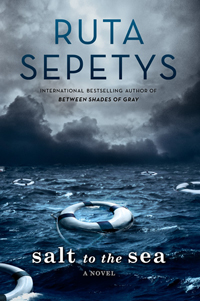Carrying Disaster on Their Backs
Ruta Sepetys’s new YA novel returns to the ravaged landscape—and people—of World War II
Most Americans are well aware of the atrocities perpetrated by Hitler during World War II, but far fewer are cognizant of the murder, rape, and other horrors of war delivered by Russian troops under Stalin. In Salt to the Sea, Ruta Sepetys—Nashville-based author of the chillingly beautiful 2011 novel, Between Shades of Gray, about a Lithuanian family sent to a Soviet work camp—tells another tale of displacement and tragedy at the end of World War II as the Red Army advances on Prussia.
 The book brings to light a maritime disaster that is also little known: the sinking of a German ship, the Wilhelm Gustloff, which resulted in more than six times the loss of life as the sinking of the Titanic. The Gustloff, meant to carry fewer than 2,000 people, was packed that day in 1945 with more than 10,000 evacuees escaping from the Russian incursion. Torpedoed by a Soviet submarine only hours into its journey, an estimated 9,343 people died, the worst loss of life during a single ship sinking in history.
The book brings to light a maritime disaster that is also little known: the sinking of a German ship, the Wilhelm Gustloff, which resulted in more than six times the loss of life as the sinking of the Titanic. The Gustloff, meant to carry fewer than 2,000 people, was packed that day in 1945 with more than 10,000 evacuees escaping from the Russian incursion. Torpedoed by a Soviet submarine only hours into its journey, an estimated 9,343 people died, the worst loss of life during a single ship sinking in history.
Salt to the Sea follows three teenagers on the run from the Red Army’s advance. All three have lost family members and are carrying painful secrets. Trekking toward safety through the cold, weak with hunger, and lost among mobs of others like them, their one hope is to take care of each other—and ultimately to board the Wilhelm Gustloff, which they pray will deliver them to freedom: “Where had they all come from?” Sepetys writes. “This endless stream of humanity clogging the small field road—did they suddenly crawl out of a hole? Had they been waiting in the forests as we had? Young women, elderly grandparents, and too many children to count. They dragged sleds, drove carts with mules, and walked with belongings slung over their back in sheets.”

Written in one- or two-page chapters, swinging from one point of view to the other, the opening of the novel has a pointillistic quality. The tiny chapters might at a glance resemble the small chapters in All The Light We Cannot See, another recent and popular World War II novel, but in that book, every section is a miniature, finished tableau. Much less information is imparted in each chapter of Salt to the Sea, and a reader might initially find the rapid shift in narrators frustrating, wanting to stay with a character longer before moving on. But as we read, the stippling of information, as in a Seurat painting, does indeed come together as a fully realized picture, drawing a landscape of ravaged Prussia and the complex and fascinating characters we are following.
By the time the Gustloff is hit by Russian torpedoes, the reader can’t help but realize how much he has come to care about these teenagers, buffeted by war but finding kindness and concern for each other, and we are deeply involved as our characters fight to survive the tragic odds.
Sepetys has a gift for evoking stirring moments of humanity in times of insufferable atrocity. Though released as a young-adult novel, Salt to the Sea, like Between Shades of Gray, will appeal to a much wider audience. And like its predecessor, it brings to life important untold history in a way that indelibly marks our hearts.

Jennie Fields received an M.F.A. in creative writing from the University of Iowa Writers’ Workshop and is the author of four novels: The Age of Desire, Lily Beach, Crossing Brooklyn Ferry, and The Middle Ages. She lives in Nashville.


